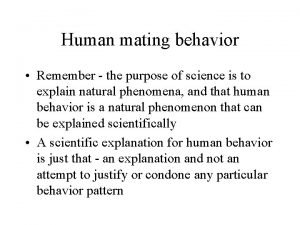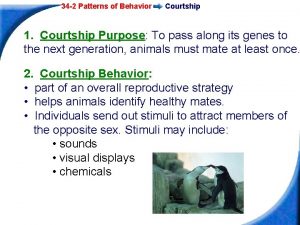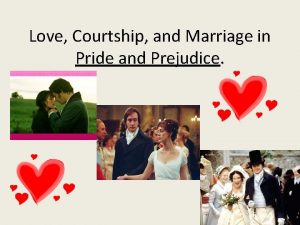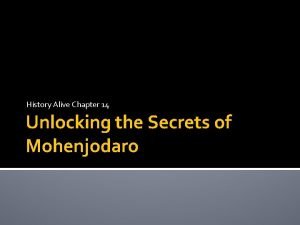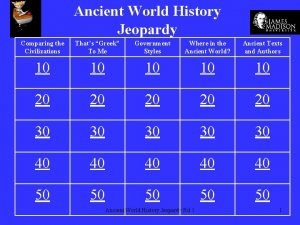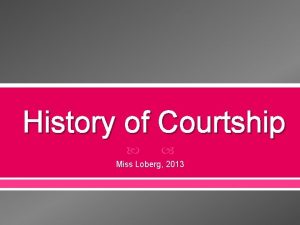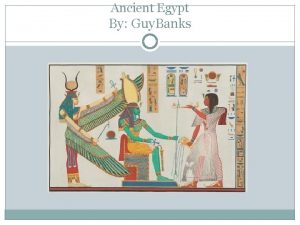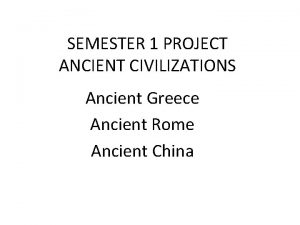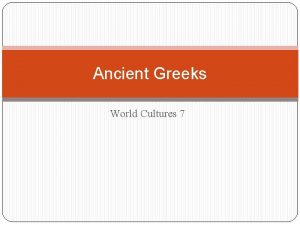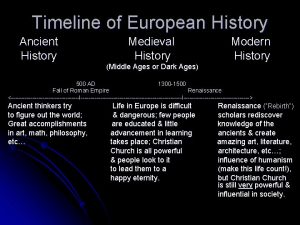History of Courtship Ancient Courtship Many of the


![http: //world. time. com/2013/11/0 5/russian-region-tolerates-bridestealing-even-after-triplemurder/ ] http: //world. time. com/2013/11/0 5/russian-region-tolerates-bridestealing-even-after-triplemurder/ ]](https://slidetodoc.com/presentation_image_h/b3f24338183cb5e3290384acee869794/image-3.jpg)























- Slides: 26

History of Courtship

Ancient Courtship Many of the first marriages were by capture, not by choice! o When there was a scarcity of women, men raided another village and captured women to take home to their village. o To avoid being caught, they would have to hide. • While hiding, they drank a drink made of honey. They also kept close eyes on the phases of the moon at the time; hence the term “honeymoon”
![http world time com2013110 5russianregiontoleratesbridestealingevenaftertriplemurder http: //world. time. com/2013/11/0 5/russian-region-tolerates-bridestealing-even-after-triplemurder/ ]](https://slidetodoc.com/presentation_image_h/b3f24338183cb5e3290384acee869794/image-3.jpg)
http: //world. time. com/2013/11/0 5/russian-region-tolerates-bridestealing-even-after-triplemurder/ ]

Chivalry Thirteenth-century said that men should honor and serve, and never do anything to displease maidens and ladies. The three main factors of the Ten Commandments of the Medieval Code of Chivalry are religion, war, and love of ladies, which shows just how important an appreciation for women was considered.

To fear God and maintain His Church To serve the liege lord in valour and faith To protect the weak and defenceless To give succour to widows and orphans To refrain from the wanton giving of offence To live by honour and for glory To despise pecuniary reward To fight for the welfare of all To obey those placed in authority To guard the honour of fellow knights To eschew unfairness, meanness and deceit To keep faith At all times to speak the truth To persevere to the end in any enterprise begun To respect the honour of women Never to refuse a challenge from an equal Never to turn the back upon a foe

Knights and Ladies… and all the “other people” Royalty could only be interested in royalty Middle class could only be interested in middle class Serfs, only serfs

Ancient Love, or Lack Thereof Marriages were business transactions. The goals were: o Economic security o Political power Marriages were arranged by men, usually fathers of the couple. Couples usually only met after arranged. http: //www. youtube. com/watch? v=Ju. RRj. N Rv-r. M

Early Death=Early Marriage

Betrothed Before Puberty When a suitable husband was found for a woman, her father paid a dowry to the groom’s family (usually money, land, or some other valuable possession) in exchange for his daughter’s hand in marriage. For the lower class, a woman’s dowry could be something as basic as a farm animal. Sometimes, wealthier families arranged for their children to marry into a friend’s family of similar status before either child could walk or talk.

Love Outside of Marriage? In the middle ages, weddings were seen as business arrangements between families, while romance was something that happened outside of marriage discreetly. The 12 th-century book The Art of Courtly Love advised that "True love can have no place between husband wife. “ According to one view, clandestine meetings between men and women, generally outside of marriage or before marriage, were the precursors to today's dating

What’s A Woman Worth? BRIDE PRICE was a sum of money (or property) paid as a gesture of sincerity. This is similar to the modern engagement ring except that the bride price usually went to the bride's father and was usually just a token.

Then and Now: The Dowry System in India Dowry (dahej) is one of the most ancient practices of India and Oxford dictionary defines it as ‘an amount of property or money brought by a bride to her husband on their marriage’

Bundling In early America, couples met because they were geographically close- simply because they were nearby and saw each other often. They would spend time together as groups, but there was little time to enjoy each others company Often they would have to travel to see each other… the fist long distance relationships were common.

This was a way to spend some quality time together without actually consummating the relationship. The woman would sometimes wear a nightdress tied at the bottom. It’s still not fully understood why both parties would both remain fully clothed. Some scholars have defended the practice on the grounds that many homes in early America had very poor, heating conditions (if any).

Victorian Dating Very formal! Almost an art form ". . the husband should always find the wife fresh, beautiful and sweet as a flower. . ". Women had a duty to look beautiful at all times but they must also ensure that ". . . they make it look like there was no effort at all. . . " It was also proper etiquette for the woman to always wear her hair up unless in the privacy of the bed chamber.

Calling All Ladies Proper etiquette and manners were everything, so a gentleman had to follow certain rules in order to successfully court a young lady. He first had to ask permission from the woman or her parents to visit, or “call, ” at a particular time. When he arrived at her parents’ house, he would leave a “calling card” (much like a business card that only listed his name). Then, the couple would enjoy a very formal visit, such as drinking tea together or playing cards in the family’s parlor or sitting room. The suitor would be allowed to call again if he impressed the young lady’s parents. -

Girls=Bad Gifts During courting it was permitted for a man to bring gifts to the lady but they had to be of a particular kind flowers, a book, perhaps sweets were also given. However, the lady could never give a present to a man until he had first given her a present. The presents given to the man had a strict code - they had to be artistic, handmade and not expensive.

“Kissed or handled in any way…” Single women in particular were never to indulge in behaviour with a man where it might in anyway lead to being 'kissed or handled in anyway'. If a man wanted to admire a necklace for example, the woman had to remove it and hand it over for inspection. Under no circumstances was the item to be inspected while she wore it. In one etiquette rule book it was firmly stated that ‘Showing affection in public was brazen vulgarity. ’

A very bad breach of etiquette was for a man to sit while a lady was left standing. He must immediately offer her the use of his own chair even if 'the gentleman has the best seat in the room, he must offer it to a lady’. However, if his seat was warm from where he had been sitting, he must go and get another seat for the lady and not offer her the one that was still warm. It was considered bad manners and vulgar to ask a direct question. A Victorian gentleman could never ask for example "How is your Mother? " They had to put the question in another form such as "I hope your Mother is doing well? " But the gentleman also had to remember not to ask a lady about anything that might offend her or upset her.

No Parlor to Sit In “More young people from small towns were drawn by the promises of city life and things like dance halls and music halls. Because those places cost money and the young men were the ones who had the money, they often paid. It became a rite of passage that the man would pay. ‘Dating’ was understood by people to be a sort of economic transaction. “

Roaring 20’s “The idea was to go out with as many people as possible, as visibly as possible, with someone as high a status as possible. ”

Going Steady In the 40’s and 50’s, people became obsessed with going steady. It was a very popular thing to have a sweetheart, especially during the war years.

Sexual Revolution In the 70’s, “free love” started to form. Women were more independent, relationships were more laidback and loose. Dates might consist of going to clubs or trips with groups of mixed sexes.

Uh. . 80’s? http: //www. youtube. com/watch? v=0 bomkg. Xe. Dk. E

90’s/2000’s vs. Now

If you had to describe what dating looks like now, what would you say? Write it on your QW
 Amish bed courtship
Amish bed courtship Difference between courting and dating
Difference between courting and dating Human courtship behavior
Human courtship behavior Section 34-2 patterns of behavior
Section 34-2 patterns of behavior Lecture on love courtship and marriage
Lecture on love courtship and marriage Purpose of courtship
Purpose of courtship Communication for primary 4
Communication for primary 4 Ancient india vs ancient china
Ancient india vs ancient china Ancient rome theater
Ancient rome theater History alive the ancient world chapter 8
History alive the ancient world chapter 8 History alive chapter 14
History alive chapter 14 Netherlands ancient history
Netherlands ancient history Tasc ancient history
Tasc ancient history From hunters and gatherers to farmers worksheet
From hunters and gatherers to farmers worksheet Chhaj doab
Chhaj doab Greek drama origin
Greek drama origin Clothing in ancient egypt
Clothing in ancient egypt Ancient civilizations jeopardy
Ancient civilizations jeopardy World history ancient civilizations through the renaissance
World history ancient civilizations through the renaissance Hình ảnh bộ gõ cơ thể búng tay
Hình ảnh bộ gõ cơ thể búng tay Ng-html
Ng-html Bổ thể
Bổ thể Tỉ lệ cơ thể trẻ em
Tỉ lệ cơ thể trẻ em Voi kéo gỗ như thế nào
Voi kéo gỗ như thế nào Thang điểm glasgow
Thang điểm glasgow Chúa yêu trần thế
Chúa yêu trần thế Môn thể thao bắt đầu bằng từ đua
Môn thể thao bắt đầu bằng từ đua


